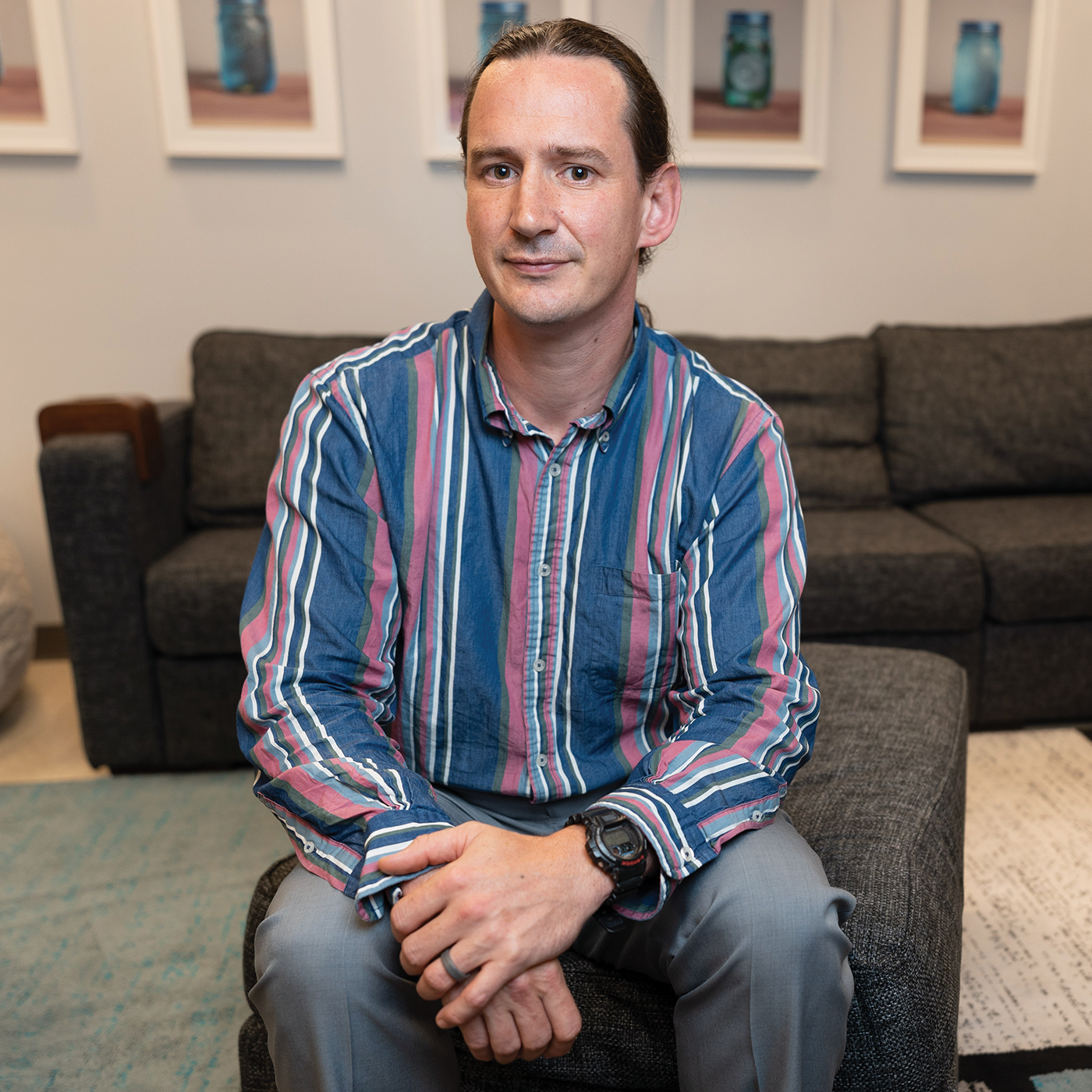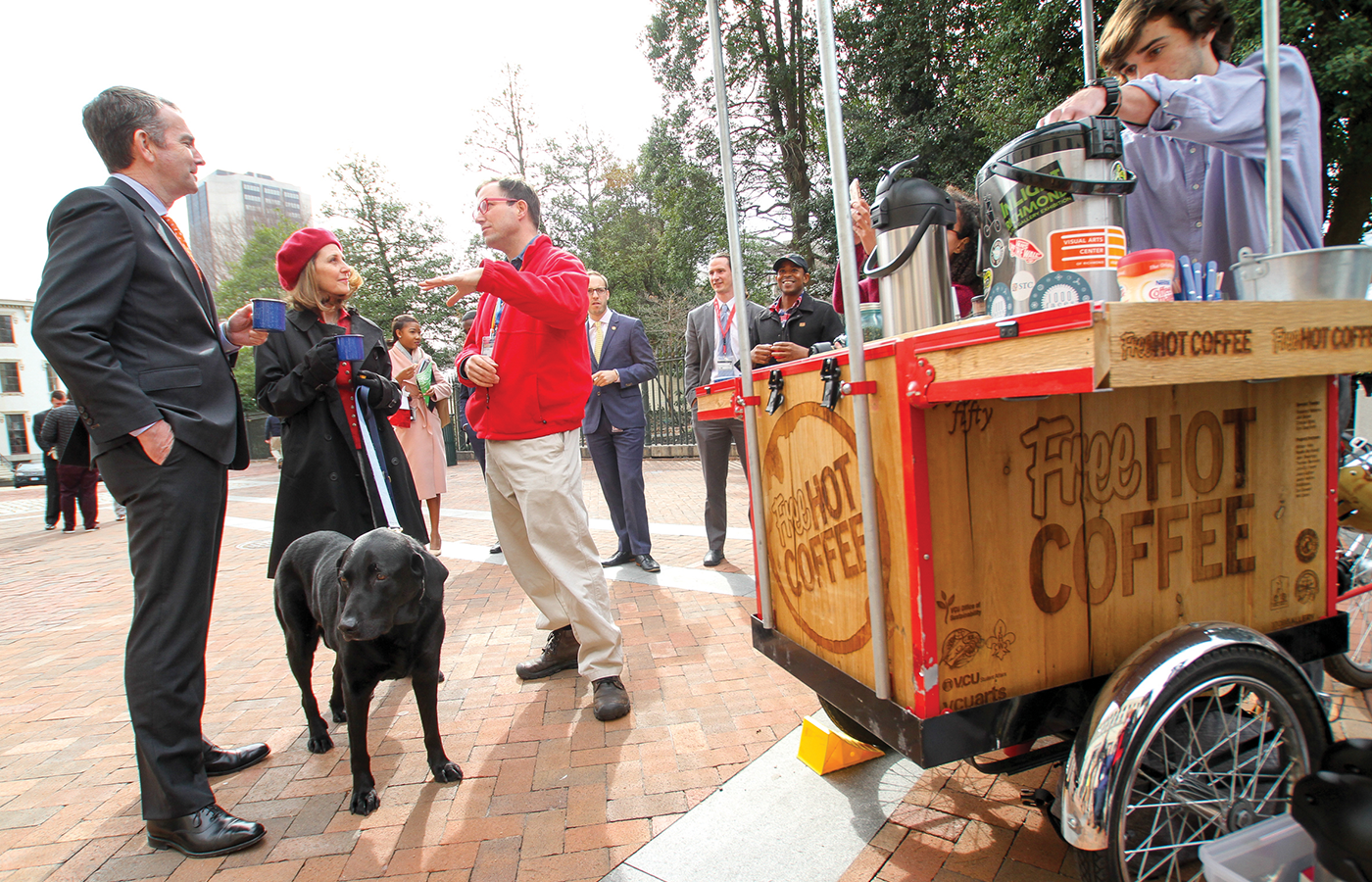
Campus & Community
Recovering ‘out loud’
A campus organization uses community to help students with substance-use disorders
When Tom Bannard (M.B.A.’16) arrived at his University of Virginia dorm room in August 2003, he brought with him some clothes, a few toiletries and a suitcase filled with liquor.
“My relationship with substances was about relief from the pressure I felt to achieve,” Bannard says. “It was also a way of connecting with folks.”
He continued drinking excessively and using drugs throughout college, but his preferred coping mechanism hardly elicited notice.
Things changed when he was arrested on felony charges in his fourth year. He decided to seek help.
Four months of residential treatment, a supportive family and a newly formed collegiate substance-use recovery organization, Hoos in Recovery, helped Bannard become sober and finish his bachelor’s
degree.
In this brief retelling, his path to sobriety sounds easy and straightforward, but recovery rarely is.
“When I got back to UVA, I was still struggling with post-acute withdrawal syndrome,” Bannard says. “I was doing OK academically because I was really showing up and putting the effort in, but I wasn’t thinking super clearly, and for about 18 months, it was a real challenge for me. Having some folks normalize that experience was super helpful. They told me, ‘You’re going to be smart again but not right now. Your brain’s working really hard to heal and learning these new patterns of behavior and thought, and that’s going to take a lot of energy.’”
Twenty years later, Bannard is a certified alcohol and drug counselor and the leader of VCU’s student recovery program, Rams in Recovery, where he tries to normalize the challenges of recovery for VCU students. Since the program began 10 years ago, Bannard has supported more than 500 participants.
“It’s been awesome, because our students do well and they graduate and do cool things,” Bannard says. “I get to work with a number of students professionally now, because a lot of them go into the fields of addiction and recovery.”
Substance use among teens and young adults seems to have changed since Bannard was in college. Research from the Centers for Disease Control and Prevention and the Substance Abuse and Mental Health Services Administration suggests drinking is less pervasive, but high-intensity drinking has remained consistent, according to the National Institute on Drug Abuse. The National Survey on Drug Use and Health says college-age young adults are the most likely to misuse opioids, and a 2022 study by the University of California-Los Angeles found that overdose deaths among adolescents skyrocketed from 2019 to 2021.
Formal treatment (e.g., hospitalization and residential and outpatient treatment programs) has long been considered the best way to find recovery, but treatment is expensive, and insurance might not cover all costs.
Participating in a residential or intensive outpatient program requires taking an extended break from school or work, which isn’t always possible. And sometimes a person finds recovery while in a treatment center, away from factors that contributed to their substance use, but they relapse when they return to their normal lives.
Community-based recovery services like Rams in Recovery can fill the gaps for people who have gone to treatment and want to sustain recovery or for those who want to pursue recovery while working toward their degrees.
In its National Drug Control Strategy, the Biden administration outlined its goal to increase the number of collegiate recovery programs by 25% by 2025.
“We’re serving a lot of older students who have never been to school or who dropped out of school and are coming back,” Bannard says. “We’re serving a fair amount of traditional-age college students as well, and folks transfer here because we have recovery support.”
“I was doing OK academically because I was really showing up and putting the effort in, but I wasn’t thinking super clearly, and for about 18 months, it was a real challenge for me. Having some folks normalize that experience was super helpful. They told me, ‘You’re going to be smart again but not right now. Your brain’s working really hard to heal.’”
Rams in Recovery started in 2013 as a student group supported by a few staff and faculty members and funded by a grant from the Transforming Youth Recovery initiative of the Nevada-based Stacie Mathewson Foundation. Mathewson had lost her son to addiction in February of that year and gave 100 colleges, chosen through an application process, $10,000 each to start recovery groups.
The group also received support from the Richmond-based JHW Foundation, established by Rosalind “Roz” and Johnny Watkins, who lost their son, John Henry Watkins III, to addiction in 2010. The JHW Foundation continues to support Rams in Recovery and other collegiate recovery programs in Virginia. Rams in Recovery has also received support from the Estes Foundation, the Baker Foundation, the Beirne Carter Foundation and private donors, including Paul and Nancy Springman.
Bannard was the group’s part-time coordinator beginning in 2015 and became full-time leader in 2017. Over the past few years, two more staff members have joined: program coordinator Lauren de Treville Powell (M.Ed.’17) and peer recovery support coordinator Omri Morris.
Like Bannard, Powell and Morris are also in recovery. That helps them do the one thing Bannard says is most critical to their work: build recovery “capital.” This includes all the supports, informal and formal, that help students heal from substance use disorder with other people who have been through it.
“If you don’t know it’s a possibility that people get well from this thing, you’re unlikely to seek help,” Bannard says. “That visible presence is a big piece of what we do, because if you don’t have a space somebody can walk into and meet five other students in recovery, then you think you’re the only one. And then you’re not successful in navigating your own recovery.
“Community recovery capital builds on itself. I think we undertreat folks, but the community- and peer-based supports can be even more robust than treatment for an individual. When we think about how to address the opioid epidemic, the overexpansion of services is a very limited solution versus thinking about how we can create and support robust recovery communities that go beyond the one-to-one stuff.”
Curbing substance use can be especially difficult when it involves leaving behind friends. People often develop social groups around their addictions (for example, the friends they party with), and it’s not easy to let them go, particularly when substance use provides a way to cope with social anxiety, insecurity or other barriers to connection.
“People have to adopt a new identity around recovery,” Bannard says. “If folks plug into community right away, it’s not such a harsh transition. Having things to do that are positive makes a big difference.”

John Freyer (in red) and members of Rams in Recovery meet with then-Gov. Ralph Northam and first lady Pam Northam at the Free Hot Coffee Bike in 2018. (Pat Kane)
Rams in Recovery builds connections through peer-support counseling, in-person and virtual meetings, sober housing and social events so students can have fun without alcohol and drugs.
A clubhouse on Marshall Street with comfy couches and a TV provides space for students to connect. A Recovery Scholars program offers scholarships and weekly in-person and virtual academic seminars on topics like career development or creativity. Students in recovery who attend any nonprofit college or university in Virginia can apply. This year, Bannard and his colleagues are raising money to enhance the program.
“By having a scholarship for students in recovery, we’re showing that we value them,” Bannard says. “Our students have very high GPAs. They are successful in their academics and go on to do really cool things. Having a scholarship recognizes that they’re a really valuable part of our community, and it also kind of gets them in the door. And then they have a space with other students in recovery and they can build that connection that allows them to prioritize their recovery.”
Rams in Recovery also has developed two programs with John Freyer, an associate professor of cross-disciplinary media in the School of the Arts. Outfitted with a free hot coffee bike that Freyer built, members of the group travel around campus to get students talking about substance use. With a free naloxone bike, they start conversations about opioid overdose, distribute naloxone (a nasal spray, brand name Narcan, that reverses an opioid overdose) and train people to use it.
“We are serving folks who are actively using substances, because that is a reality,” Morris says. “If we don’t acknowledge that — particularly as a collegiate recovery program working on a college campus where substance use is normalized as a part of college society and college experience — then we’re not doing our jobs, and we’re not serving that need in the community.
“We work together to reach the folks who want to moderate their use or want to create healthier relationships with their substance of choice. We’re not saying to them, ‘You have to stop.’ That is not my job. My job is to meet you where you’re at and say, ‘How can I help you? What kind of support would you like for me to give you?’ Recovery is self-determined and self-identified. Sometimes these students end up realizing they have a bigger issue than they think they do and decide to pursue recovery.”
The staff of Rams in Recovery model what it’s like to choose recovery and “recover out loud.” They openly talk about past substance use rather than keeping it secret out of shame or fear of punishment. They hope they can give students the courage to share their own experiences when they finish school and enter the workforce. “It’s like we’re building the bench for the recovery movement,” Bannard says.
“My mom had somebody who worked for her who was in recovery,” Bannard says. “That’s how I got introduced to recovery. If he [hadn’t been] open with his boss that he was in recovery, I probably wouldn’t be alive today.”
